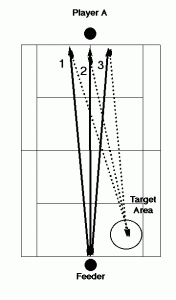| Step #1 — Have players line up on the baseline, at the center of the court in a single-file line. NOTE: The drill is described for one player at a time. If you have limited facilities, you may have players line up in two lines, one on each side of the court [deuce and ad] with different target areas across the net. Step #2 — Feed player several forehands to the player’s right allowing her to hit several forehands down the line and crosscourt.
Step #3 — Begin to feed forehands directly toward the players’ body, forcing her to move to her right to play a forehand. She may not hit any backhands during this drill. Make sure she hits all forehands with her weight going into the shot and toward a pre-determined target area.
Step #4 — Begin to feed balls slightly to the left of the players’ body (backhand), requiring her to quickly run around the backhand in order to hit the ball with an inside-out forehand. She may not hit any backhands during this drill. Again, make sure she hits all forehands with her weight going into the shot and toward a pre-determined target area.
Options — Have players hit to only one target area (e.g., deep and crosscourt), grooving the shot before moving to the next target area (e.g., deep and down the line). End with the player hitting to multiple targets.
As with any dead-ball drill, it is important that players receive three balls before moving to the end of the line in order to gain any meaningful learning and motor pattern development. Hitting one ball and running to the end of the line not only promotes improper body balance, but does not contribute to long-term retention and recall of skills.
Also, before returning to the end of the line, the player should move forward and touch a spot on the court with his or her racquet in order to make sure that the player moves their weight into the shot, rather than falling out of the last shot in order to get to the back of the line. Making players move forward before they move backward (toward the end of the line) ensures repetitions of only proper body balance.
Summary
The key to the inside-out forehand is getting into proper position and getting the weight back into the ball. Practicing the inside-out forehand and the footwork, positioning and body balance that goes with it will help you players add a significant weapon to their games! |







